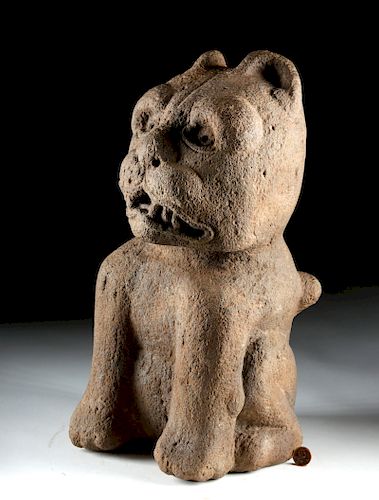Large Superb Aztec Stone Feline - Von Winning Papered
Lot 144c
About Seller
Artemis Fine Arts
686 S Taylor Ave, Ste 106
Louisville, CO 80027
United States
Selling antiquities, ancient and ethnographic art online since 1993, Artemis Gallery specializes in Classical Antiquities (Egyptian, Greek, Roman, Near Eastern), Asian, Pre-Columbian, African / Tribal / Oceanographic art. Our extensive inventory includes pottery, stone, metal, wood, glass and textil...Read more
Estimate:
$30,000 - $45,000
Absentee vs Live bid
Two ways to bid:
- Leave a max absentee bid and the platform will bid on your behalf up to your maximum bid during the live auction.
- Bid live during the auction and your bids will be submitted real-time to the auctioneer.
Bid Increments
| Price | Bid Increment |
|---|---|
| $0 | $25 |
| $300 | $50 |
| $1,000 | $100 |
| $2,000 | $250 |
| $5,000 | $500 |
| $10,000 | $1,000 |
| $20,000 | $2,500 |
| $50,000 | $5,000 |
| $100,000 | $10,000 |
| $200,000 | $20,000 |
About Auction
By Artemis Fine Arts
Feb 21, 2019
Set Reminder
2019-02-21 10:00:00
2019-02-21 10:00:00
America/New_York
Bidsquare
Bidsquare : Exceptional Antiquities, Asian, Ethnographic
https://www.bidsquare.com/auctions/artemis-gallery/exceptional-antiquities-asian-ethnographic-3858
An important one-day auction featuring museum-worthy examples of Egyptian, Greek, Roman, Etruscan, Near Eastern, Far East / Asian, Pre-Columbian, African / Tribal, Oceanic, Native American, Spanish Colonial, Russian, Fossils, Ancient Jewelry, Fine Art, so much more! Artemis Fine Arts info@artemisfinearts.com
An important one-day auction featuring museum-worthy examples of Egyptian, Greek, Roman, Etruscan, Near Eastern, Far East / Asian, Pre-Columbian, African / Tribal, Oceanic, Native American, Spanish Colonial, Russian, Fossils, Ancient Jewelry, Fine Art, so much more! Artemis Fine Arts info@artemisfinearts.com
- Lot Description
Pre-Columbian, Mexico City region, Aztec, Post-classic Mexico, ca. 1300 to 1500 CE. Wow! A delightful sculpture, carved from volcanic stone, depicting what appears to be a young jaguar, sitting upright and alert. Although the stone is weathered, the fierce features are still exceptionally clear. It has an oversized head, contributing to its youthful appearance, with round ears, puffy brows, and deeply carved eyes that likely once had inlays of precious metal or stone. The mouth is slightly open, with large fangs, and a deep opening between the front teeth that may have had an inlaid tongue made of some other material. The body is compact, with carved paws, legs, and a long tail in relief on the back. The jaguar was one of the most powerful symbols in Aztec life. Size: 7" L x 7.25" W x 15.7" H (17.8 cm x 18.4 cm x 39.9 cm)
The jaguar - "ocelotl" in Nahautl - was associated with military and social power, war, night, black magic, and the god of darkness, Tezcatlipoca, "Smoking Mirror", who sometimes appeared in jaguar form. Rulers are often depicted dressed in jaguar skins or sitting on them. One of the two classes of elite soldiers in Aztec society were the jaguar warriors, who were believed to embody the ferocity of the animal itself - in order to become a jaguar warrior, they had to capture four enemies in battle who would later be sacrificed. This statue may have graced a military academy where jaguar warriors trained.
The Spaniards wrote that the Aztecs believing that stone quarried to be carved had magical properties and was alive, able to speak and prophecy. While today we classify rocks scientifically, i.e. igneous, sedimentary, etc., the Aztecs had a very different method for classifying them. Different rocks that they used in lapidary work (and shell, which they also considered a form of rock) were classified according to properties like brightness, density, healing power, and magical ability. Aztec stone sculpture is a culmination of centuries of stone carving in Mesoamerica, and, using fragile volcanic stone, they were able to create remarkably naturalistic and detailed artworks.
This piece includes a written assessment by Mesoamerican expert Hasso von Winning, Ph.D., which physically describes the piece and then states, "I have inspected this stone Jaguar and it is an authentic Aztec artifact."
Provenance: private Bel Air, California, USA collection, acquired in 1972 from Jules Berman
All items legal to buy/sell under U.S. Statute covering cultural patrimony Code 2600, CHAPTER 14, and are guaranteed to be as described or your money back.
A Certificate of Authenticity will accompany all winning bids.
We ship worldwide and handle all shipping in-house for your convenience.
#143254Weathered surface commensurate with age, including deposits in lower profile areas. Most weathering is from the lower part of the body, with the head nicely preserved. A few tiny losses from edges, but overall excellent condition.Condition
- Shipping Info
-
All shipping is handled in-house for your convenience. Your invoice from Artemis Gallery will include shipping calculation instructions. If in doubt, please inquire BEFORE bidding for estimated shipping costs for individual items.
-
- Buyer's Premium



 EUR
EUR CAD
CAD AUD
AUD GBP
GBP MXN
MXN HKD
HKD CNY
CNY MYR
MYR SEK
SEK SGD
SGD CHF
CHF THB
THB
















